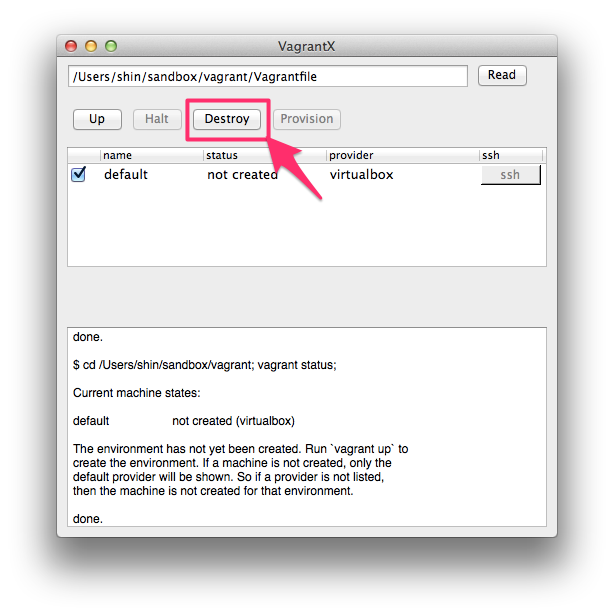


If you add many roles, you may need to increase memory available to the Vagrant VM. Roles has more information about some roles.
Vagrant destroy how to#
Watch a short screencast demonstrating how to use roles. # After you are done enabling and/or disabling roles, run this to make the change take effect. $ vagrant roles disable role # Turn off role for this machine. $ vagrant roles enable role # Turn on role for this machine.
Vagrant destroy software#
These optional software stacks are collectively known as 'roles', and MediaWiki-Vagrant offers an easy and powerful command-line interface for managing them. MediaWiki-Vagrant sets up a basic MediaWiki instance by default, but it also knows how to configure a range of complementary software, including some popular MediaWiki extensions and their dependencies. Best of all, because the configuration is automated and contained in a virtual environment, mistakes are easy to undo. The virtual machine that MediaWiki-Vagrant creates makes it easy to learn about, modify, and improve MediaWiki's code: useful debugging information is displayed by default, and various developer tools are set up specifically for inspecting and interacting with MediaWiki code, including a powerful debugger and an interactive interpreter. Since the configuration is geared towards easy development rather than security, MediaWiki-Vagrant is not recommended for publicly accessible wikis. It consists of a set of configuration scripts for Vagrant and VirtualBox that automate the creation of a virtual machine that runs MediaWiki. D:\> vagrant destroy dd68a71 vagrant2: Are you.
Vagrant destroy portable#
MediaWiki-Vagrant is a portable MediaWiki development environment. To interact with any of the machines, you can go to that directory and run Vagrant, or you can use the ID directly with Vagrant commands from any directory. This all seems a bit clunky and I'm wondering if there's a better solution.Visual overview of vagrant Το λογότυπο του MediaWiki Vagrant Bryan Davis explains in an interview at Wikimania what MediaWiki Vagrant is TechTalk on MediaWiki-Vagrant by Bryan Davis and Dan Duvall Slides from TechTalk on MediaWiki-Vagrant by Bryan Davis and Dan Duvall On AWS, we've done used Python's Flask and boto package to terminate boxes in a similar manner.

Quesion) Is it possible for a Vagrant VM to destroy itself or power itself off?Ī colleague suggested that we create a RESTful endpoint on the host that, on completion of a long-running job, the guest makes a call that triggers a vagrant destroy in the folder of the Vagrant box. However, simply performing a 'shutdown now' in the Ansible playbook doesn't stop the VM from running: $ vagrant status => default: Running provisioner: ansible. When I run this manually: $ vagrant upīringing machine 'default' up with 'virtualbox' provider.ĭefault: /vagrant => /Users/awoolford/Documents/vagrantCronjob I tried adding a shutdown now to the playbook, but that didn't stop the VM. Ideally, I'd like to provision a box to perform some long-running task and, once it's complete, destroy the Vagrant box or at least power off. and the Ansible playbook: # vagrantCronjobPlaybook.yml nfigure(VAGRANTFILE_API_VERSION) do |config|Ĭonfig.vm.provision "ansible" do |ansible|Īaybook = "vagrantCronjobPlaybook.yml" Here's a minimal example of the Vagrantfile: # -*- mode: ruby -*. This has provided some flexibility and transparency: jobs can be easily be moved around and the YAML playbook provides some level of documentation. I've been using Vagrant with Ansible to perform certain ETL tasks.


 0 kommentar(er)
0 kommentar(er)
